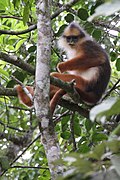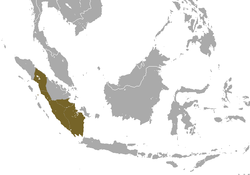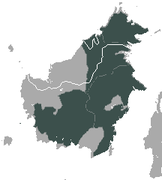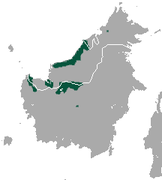| Common name | Scientific name and subspecies | Range | Size and ecology | IUCN status and estimated population |
|---|
| Black Sumatran langur
| P. sumatrana
(S. Müller & Schlegel, 1841) | Island of Sumatra in Indonesia | Size: 42–61 cm (17–24 in) long, plus 50–85 cm (20–33 in) tail [11]
Habitat: Forest [12]
Diet: Fruit, leaves, seeds and flowers [12] | EN
Unknown  [12] [12]
|
|---|
| Black-and-white langur
| P. bicolor
Aimi & Bakar, 1992 | Island of Sumatra | Size: 42–61 cm (17–24 in) long, plus 50–85 cm (20–33 in) tail [11]
Habitat: Forest [13]
Diet: Fruit, seeds, and leaves [11] | DD
Unknown  [13] [13]
|
|---|
| Black-crested Sumatran langur  | P. melalophos
(Raffles, 1821) | Island of Sumatra
 | Size: 42–61 cm (17–24 in) long, plus 50–85 cm (20–33 in) tail [11]
Habitat: Forest and shrubland [14]
Diet: Fruits and leaves, as well as seeds and flowers [15] | EN
Unknown  [14] [14]
|
|---|
| East Sumatran banded langur
| P. percura
Lyon, 1908 | Island of Sumatra | Size: 42–61 cm (17–24 in) long, plus 50–85 cm (20–33 in) tail [11]
Habitat: Forest [16]
Diet: Fruit, seeds, and leaves [11] | CR
Unknown  [16] [16]
|
|---|
| Hose's langur  | P. hosei
(Thomas, 1889) | Borneo
 | Size: 42–61 cm (17–24 in) long, plus 50–85 cm (20–33 in) tail [11]
Habitat: Forest [17]
Diet: Leaves, unripe fruits, seeds, flowers, bird eggs and nestlings [17] | VU
Unknown  [17] [17]
|
|---|
| Javan surili  | P. comata
(Desmarest, 1822)
- P. c. comata
- P. c. fredericae
| Island of Java in Indonesia
 | Size: 42–61 cm (17–24 in) long, plus 50–85 cm (20–33 in) tail [11]
Habitat: Forest [18]
Diet: Leaves, as well as fruits, flowers, and seeds [18] | VU
5,500  [18] [18]
|
|---|
| Maroon leaf monkey  | P. rubicunda
(S. Müller, 1838)
- P. r. carimatae
- P. r. chrysea
- P. r. ignita
- P. r. rubicunda
- P. r. rubida
| Borneo
 | Size: 42–61 cm (17–24 in) long, plus 50–85 cm (20–33 in) tail [11]
Habitat: Forest and inland wetlands [19]
Diet: Leaves, seeds, and fruit, as well as flowers and pith [19] | VU
Unknown  [19] [19]
|
|---|
| Siberut langur  | P. siberu
(Chasen & Kloss, 1928) | Island of Siberut in Indonesia
 | Size: 42–61 cm (17–24 in) long, plus 50–85 cm (20–33 in) tail [11]
Habitat: Forest [20]
Diet: Fruit, seeds, and leaves [11] | EN
Unknown  [20] [20]
|
|---|
| Mentawai langur
| P. potenziani
(Bonaparte, 1856) | Mentawai islands in Indonesia
 | Size: 42–61 cm (17–24 in) long, plus 50–85 cm (20–33 in) tail [11]
Habitat: Forest [21]
Diet: Fruit, seeds, and leaves [11] | CR
Unknown  [21] [21]
|
|---|
| Miller's langur  | P. canicrus
G. S. Miller, 1934 | Eastern Borneo (in light green)
 | Size: 42–61 cm (17–24 in) long, plus 50–85 cm (20–33 in) tail [11]
Habitat: Forest [22]
Diet: Fruit, seeds, and leaves [11] | EN
Unknown  [22] [22]
|
|---|
| Mitered langur  | P. mitrata
Eschscholtz, 1821 | Island of Sumatra | Size: 42–61 cm (17–24 in) long, plus 50–85 cm (20–33 in) tail [11]
Habitat: Forest [23]
Diet: Fruit, seeds, and leaves [11] | VU
Unknown  [23] [23]
|
|---|
| Natuna Island surili
| P. natunae
(Thomas & Hartert, 1894) | Island of Natuna Besar in Indonesia
 | Size: 42–61 cm (17–24 in) long, plus 50–85 cm (20–33 in) tail [11]
Habitat: Forest [24]
Diet: Fruit, seeds, and leaves [11] | VU
9,000  [24] [24]
|
|---|
| Raffles' banded langur  | P. femoralis
(Martin, 1838) | Singapore and southern Peninsular Malaysia
 | Size: 42–61 cm (17–24 in) long, plus 50–85 cm (20–33 in) tail [11]
Habitat: Forest [25]
Diet: Fruit, seeds, and leaves [11] | CR
200–250  [25] [25]
|
|---|
| Robinson's banded langur  | P. robinsoni
Thomas, 1910 | Southern Malay Peninsula
 | Size: 42–61 cm (17–24 in) long, plus 50–85 cm (20–33 in) tail [11]
Habitat: Forest [26]
Diet: Fruit, seeds, and leaves [11] | NT
Unknown  [26] [26]
|
|---|
| Sabah grizzled langur
| P. sabana
(Thomas, 1893) | Eastern Borneo (in dark brown)
 | Size: 42–61 cm (17–24 in) long, plus 50–85 cm (20–33 in) tail [11]
Habitat: Forest [27]
Diet: Fruit, seeds, and leaves [11] | EN
Unknown  [27] [27]
|
|---|
| Sarawak surili  | P. chrysomelas
(S. Müller, 1838)
- P. c. chrysomelas
- P. c. cruciger
| Northern Borneo
 | Size: 42–61 cm (17–24 in) long, plus 50–85 cm (20–33 in) tail [11]
Habitat: Forest [5]
Diet: Fruit, seeds, and leaves [11] | CR
Unknown  [5] [5]
|
|---|
| Thomas's langur  | P. thomasi
(Collett, 1893) | Northern island of Sumatra in Indonesia
 | Size: 42–62 cm (17–24 in) long, plus 50–85 cm (20–33 in) tail [28]
Habitat: Forest [29]
Diet: Fruit, leaves, and seeds, as well as flowers, bark, twigs, stalks, birds, bird eggs, algae, and insects [28] | VU
Unknown  [29] [29]
|
|---|
| White-fronted surili  | P. frontata
(S. Müller, 1838) | Borneo
 | Size: 42–61 cm (17–24 in) long, plus 50–85 cm (20–33 in) tail [11]
Habitat: Forest [30]
Diet: Fruit, seeds, and leaves [11] | VU
Unknown  [30] [30]
|
|---|
| White-thighed surili  | P. siamensis
(S. Müller & Schlegel, 1838)
- P. s. cana
- P. s. paenulata
- P. s. rhionis
- P. s. siamensis
| Southeastern Asia
 | Size: 42–61 cm (17–24 in) long, plus 50–85 cm (20–33 in) tail [11]
Habitat: Forest [31]
Diet: Fruit, seeds, and leaves [11] | NT
Unknown  [31] [31]
|
|---|




























